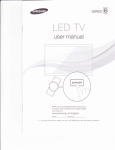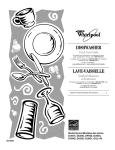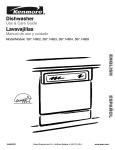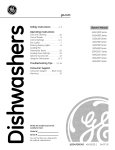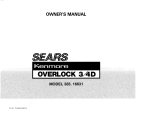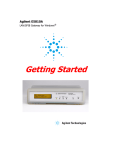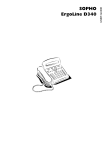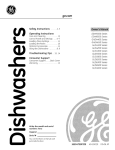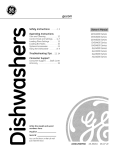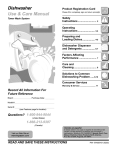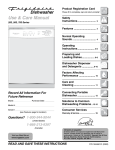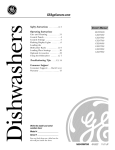Download Frigidaire 700 SERIES Dishwasher User Manual
Transcript
Product Registration
Dishwasher
Please fill in completely, sign and return promptly!
Safety
Instructions
700 Series
Card
.........................
2
Features ..............................
3
Normal Operating
Sounds ................................
4
Operating
Instructions
.......................
4-6
Preparing and
Loading Dishes .................
6-8
Dishwasher Dispenser
and Detergents ................ 9-10
Record All Information
Future Reference
Brand:
For
Purchase Date:
Model #:
Factors Affecting
Performance ......................
10
Care and
Cleaning .............................
11
Connecting
Dishwasher
12
Solutions to Common
Dishwashing Problems d3-1s
Consumer
Serial #:
(see Features page for location)
Portable
........................
Services
Warranty & Service ..............................
16
Questions?
(United States)
(Canada)
READ AND SAVE THESE INSTRUCTIONS
P/N154457201
(0103)
Important Safety Instructions
This symbol will help alert you to such
dangers as personal injury, burns, fire and
electrical shock.
To reduce the risk of fire, electrical shock, or
injury when using your dishwasher, follow
basic precautions including the following:
Read all instructions
dishwasher.
before using your
Use your dishwasher only as instructed
this Use and Care Manual.
Disconnect electrical
before servicing.
power to dishwasher
Repairs should be done by a qualified
technician.
Do not tamper with controls.
in
This Manual does not cover every possible
condition and situation that may occur. Use
common sense and caution when installing,
operating and maintaining any appliance.
DISHWASHER
MUST BE ELECTRICALLY
GROUNDED. Read the Installation
Instructions for details.
•
This dishwasher is designed to operate on
regular house current (120 V, 60 Hz). Use a
circuit equipped with a 15 ampere fuse or
circuit breaker. Use a 20 ampere fuse if
dishwasher is connected with a food waste
disposer.
•
Do not operate dishwasher unless all
enclosure panels are in their proper place.
To avoid entrapment and/or suffocation,
remove door or door latch mechanism from
any dishwasher that is discarded or not in
•
Do not wash plastic items unless marked
"dishwasher safe" or the equivalent. Check
with manufacturer
for recommendations,
if
not marked. Items that are not dishwasher
safe may melt and create a potential fire
hazard.
If the dishwasher drains into a food
disposer, make sure disposer is completely
empty before running dishwasher.
use.
Keep young children and infants away from
dishwasher when it is operating.
Do not let children abuse, sit, stand or play
on door or racks of a dishwasher.
Do not touch the heating element
immediately after use.
during or
When loading items to be washed:
- Locate sharp items and knives so that
they are not likely to damage the door
seal or tub.
- Load sharp items and knives with the
handles up to reduce the risk of cut-type
injuries.
Under certain conditions, hydrogen gas
may be produced in a hot water system that
has not been used for 2 weeks or more.
HYDROGEN GAS IS EXPLOSIVE.
If hot
water system has not been used for such a
period, before using dishwasher, turn on all
hot water faucets and let water flow from
each for several minutes. This will release
any accumulated
hydrogen gas.
HYDROGEN GAS IS FLAMMABLE.
Do not
smoke or use an open flame during this
time.
Do not store or use combustible materials,
gasoline or other flammable vapors and
liquids in the vicinity of this or any other
appliance.
Use only detergents and rinse agents
recommended
for use in a dishwasher.
Store dishwasher detergent and rinse
agents out of the reach of children.
SAVE THESE
INSTRUCTIONS
©2003 Electrolux Home Products,
All rights reserved.
Inc.
Printed in U.S.A.
Dishwasher Features
Your dishwasher cleans by spraying a mixture of hot water and detergent through the spray arms
against soiled surfaces. Each cycle begins with a pre-drain. Next, the dishwasher fills with water
covering the filter area. Water is then pumped through the filter and spray arms. Soil particles go
down the drain as the water is pumped out and replaced with clean water. The number of water fills
will vary with the cycle being used.
Tub Gasket
page 11
,_
Funnel
pages \
7,13
Nozzle
_Top
Spray
pages
8,13
Overfill
page
Label
(located on right
side of tub)
/
Bottom
Arm
_page
Protector
8
Rack
jGlass
Trap
page 11
11
_Self-Cleaning
page 11
Prewash Detergent Cup \
page 9
_Heating
Detergent Dispenser
page 9
page 11
Rinse Aid
Dispenser
Rack
page 7
Serial
Middle Spray Arm
pages 7,13
Lower
and Upper Spray
(some models)
_
page 10
Vent
pages
4,6,14
3
Filter
Element
Operating Instructions
Appearance
Very Important
Information Read
Before
Operating Your Dishwasher!
NormalOperating
Sounds
This dishwasher
dishwashers--IT'S
Your Precision Wash Systerr_
dishwasher
uses energy efficient motors for the wash
and drain portions of the cycle you select.
Each cycle has a series of water fills and
drains for washing and rinsing dishes. As
each cycle begins, you may-or may nothear the drain motor.
The next sound you will hear is the
splashing water as it enters the tub. Then the
lower arm rotates and circulates water. This
is followed by a pause and a slightly different
sound as the middle arm sprays water. If you
listen closely, you will hear the change in
sound as the wash action switches from one
arm to the other.
PLEASE BE ADVISED: If you compare
this dishwasher to previous models, you
may be surprised at what you DON'T
hear!
Getting Started
(See Preparing
2. Add detergent (See Dishwasher Dispenser
& Detergents).
3. Add rinse aid, if needed (See Rinse Aid).
4. Turn dial clockwise to select cycle (See
Cycle Chart) or number of hours for delay
start.
5. Select desired energy OPTIONS (See
Energy Options). The indicator will show red
when selected.
does not sound like most
QUIETER.
1. Load dishwasher
Loading Dishes).
may vary from your model.
and
6. If using DELAY START, go to step number
9.
7. For instructions on connecting the portable
dishwasher, see "Connecting and
Disconnecting
the Portable/Convertible
Dishwasher"
8. Run hot water faucet nearest dishwasher
until water is hot. Turn water off.
9. To start, close door to latch.
Delay Start
Allows you to delay starting the POTS & PANS
cycle.
• Turn dial to select number of hours.
• Select HI-TEMP WASH ON option and
other desired options.
• Close door to latch. The DELAY START light
(available select models) will come on.
Plate Warmer (available
select
models)
For warming dishes and serving plates before
serving hot foods:
• Load clean plates and dishes to be warmed.
• Turn dial to PLATE WARMER.
• Select HEAT DRY ON option.
Operating Instructions (continued)
Wash Cycle Selections
Note: Cycle times are approximate
and will vary with options
Cycle
Cycle
Description
To Select Cycle
Pots &
Pans
For pots, pans,
casseroles, and
dinnerwarewithdried-onor
baked-onsoils.
•
•
•
•
Heavy
Wash
For heavily soiled dishes
andsilverware.
Normal
Wash
selected.
Not all cycles available
on all models.
Chart
Water
(approx.)
Time*
(approx.)
Washes/
Rinses
Press MAIN CYCLES pad.
Select HI-TEMP WASH ON option.
Select other desired options.
Turn dial to POTS & PANS.
7.2 gal.
6.0 imp. gal.
27.3 liters
84 min.
2 washes
4 rinses
• Turn dial to POTS & PANS/HEAVY
WASH.
• Select desired OPTIONS.
7.2 gal.
6.0 imp. gal.
27.3 liters
82 min.
2 washes
4 rinses
For regularly soiled dishes • Press MAIN CYCLES pad.
andsilverware.
• Select desired options.
• Turn dial to NORMAL WASH.
6.0 gal.
5.0 imp. gal.
22.7 liters
78 min.
2 washes
3 rinses
Light
For lightly soiled or prerinsed dishes and
silverware.
• Press MAIN CYCLES pad.
• Select desired options.
• Turn dial to LIGHT/CHINA.
4.8 gal.
4.0 imp. gal.
18.2 liters
71 min.
1 wash
3 rinses
China
For lightly soiled china
and crystal.
• Press CHINA ONLY pad.
• Select drying option.
• Turn dial to LIGHT/CHINA.
Note: HI-TEMP WASH cannot be
activated with this cycle.
4.8 gal.
4.0 imp. gal.
18.2 liters
71 min.
1 wash
3 rinses
Glasses
For glasses and other
lightly soiled items.
• Press MAIN CYCLES pad.
• Select desired options.
• Turn dial to GLASSES.
3.6 gal.
3.0 imp. gal.
13.6 liters
63 min.
1 wash
2 rinses
Rinse
Hold
For rinsing dishes that will • DO NOT USE detergent.
be washed later.
• Turn dial to RINSE HOLD.
• Select HEAT DRY OFF.
1.2 gal.
1.0 imp. gal.
4.5 liters
12 min.
1 rinse
* Includes dry time.
Energy Options
Hi-Temp Wash Option
Heat Dry Option
When HI-TEMP WASH ON option is selected, the
dishwasher heats the water in the main wash to
HEAT DRY ON option provides faster drying since
the heating element is on during the drying portion
of cycle.
approximately
140°F (60°C). Wash action will
continue but timer will not advance until proper
temperature
is reached. The hotter water provided
by this option helps activate dishwasher detergent
to clean food grease and soil from dishes. HITEMP WASH ON option can be used with any
cycle except RINSE HOLD.
To turn off option,
select HI-TEMP
Hi-Temp Rinse Option
select models)
WASH
HEAT DRY OFF option saves electricity since the
heating element is off during the drying portion of
cycle. To speed drying process, open the door
slightly after the cycle is complete. Some water
droplets may remain on door and tub and in areas
where dishes touch silverware basket and rack.
OFF.
With either option, you may see water vapor
coming from vent during the washing and/or drying
portion of cycle. On some models, the vent is
closed during washing to hold moisture and sound
inside and then opens for drying.
(available
When HI-TEMP RINSE ON option is selected, the
dishwasher heats the water in the final rinse to
approximately
140°F (60°C). This will speed
drying and reduce spotting. HI-TEMP RINSE ON
option can be used with any cycle except RINSE
HOLD.
To turn off option, select HI-TEMP
RINSE
The drying option may be changed at any time
during the cycle and affects only the drying period.
OFF.
5
Operating
Instructions (continued)
Status Indicator Lights
(available select models)
When DELAY START option is selected, the
Delay Start light will glow as timer counts
down to begin cycle.
The WASHING LIGHT comes on at the
beginning of the cycle and remains on until the
end of the main wash.
CLEAN light comes on when a cycle is
complete. To turn it off, turn dial slightly until
light goes off.
Preparing and
Loading Dishes
Dish Preparation
Scrape away large pieces of food, bones, pits,
toothpicks, etc. The continuous filtered wash
system will remove remaining food particles.
Burned-on foods should be loosened before
loading. Empty liquids from glasses and cups.
Foods such as mustard, mayonnaise, vinegar,
lemon juice and tomato based products may
cause discoloration of stainless steel and
plastics if allowed to sit for a long period of
time. Unless the dishwasher is to be operated
at once, it is best to rinse off these food soils.
Load racks so that large items do not
prevent the detergent dispenser from
opening.
Check manufacturer's
recommendations
before washing items in question.
If the dishwasher drains into a food
disposer, be sure disposer
is completely
empty before starting
dishwasher.
Preparing and Loading Dishes (continued)
Loading the Top Rack
Loading the Bottom Rack
Features and appearance of racks and
silverware basket may vary from your model.
Features and appearance of racks and
silverware basket may vary from your model.
Important:
loading.
Make sure tall items do not block spray arm
rotation.
Do not cover the funnel when
The top rack is designed for cups, glasses
small plates, saucers and bowls.
Place plates and platters so that they do not
touch.
Load glasses in top rack. Damage
if placed in bottom rack.
Place bowls, casseroles and sauce pans with
the soiled surface facing down or toward the
center. Tilt slightly for better drainage.
may occur
Load plastic items in top rack only. Melting
may occur if placed in bottom rack.
Be sure pan handles do not protrude through
the bottom of the rack and block the spray arm
rotation.
Load items with open ends facing down for
better cleaning and draining.
Damage may occur if delicate
each other during dishwasher
items touch
operation.
Long-handled
knives and utensils
placed in top rack.
can be
Be sure nothing protrudes through the bottom
of the rack to block rotation of middle spray
arm.
Do not cover funnel
7
Preparing and Loading Dishes (continued)
Loading the Silverware
Basket
Mix spoons, forks and knives to prevent
nesting. Mixing items gives better cleaning
drying.
Adding a Dish
and
To add or remove items after wash cycle
starts:
• Unlatch door and wait a few seconds until
wash action stops before opening.
• Add the item and wait a few seconds to
allow cold air to slowly expand inside
dishwasher.
• Close door firmly to latch and resume cycle.
For safety, load sharp knives and forks with
handles up.
Be sure nothing protrudes through bottom of
basket or rack to block the spray arm.
Do not mix silver and stainless to avoid
damaging the silver finish.
Dishwasher Dispenser & Detergents
Filling the Detergent Dispenser
How much Detergent to use
The detergent dispenser has one covered and one
uncovered cup. Detergent in the uncovered cup falls
into the dishwasher when the door is closed. The
The amount of detergent to use depends on the
water hardness. Water hardness is measured in
grains per gallon. Using too little detergent can
result in poor cleaning and hard water filming or
spotting. Using too much detergent in soft water
can cause a permanent film called etching. Your
local water company, water softener company or
county extension agent can tell you the water
hardness in your area.
covered
cup
detergent.
opens
automatically
to
release
•
Use only fresh automatic dishwashing
detergent. Other detergents will cause
oversudsing.
•
When using automatic dishwashing detergent
tabs, place one tab in main wash cup and
close.
•
Add detergent
just before starting
•
Store detergent
in a cool, dry location. Moist
or caked detergent will not dissolve properly.
Pre Wash Cup
Cover
cycle.
Latch
Main Wash Cu
\
Note: If the cover is closed on the Main Wash
Cup, open by pressing
the cover
latch.
Detergent Usage Guide
Cycle
Soft Water
(0-3 grains)
Medium Hard Water
(4-8 grains)
Hard Water
(9-12 grains)
Very Hard Water*
(over 12 grains)
Pots & Pans
2 teaspoons
5 teaspoons
8 teaspoons
Each Cup-
Heavy Wash
(each cup1/4 full)
Normal
(each cupcompletely full)
Wash
Light
2 teaspoons
China
(Main Wash cup-
Glasses
1/4 full)
Rinse
(each cup-fill to line
above "Regular")
Hold
No Detergent
5 teaspoons
(Main Wash cup-fill
line above "Regular")
No Detergent
8 teaspoons
to
(Main Wash cupcompletely
full)
No Detergent
Completely
Full
(water softener
recommended)
Main Wash CupCompletely
Full
(water softener
recommended)
No Detergent
(water softener
recommended)
*Note: For very hard water, detergent alone may not be enough. A water softener is recommended
to
improve water quality and dishwashing performance. Try adding more detergent at the beginning of the
main wash portion of the cycle. As a rule, use 1 teaspoon for each grain above 12. Unlatch the door, open
slowly and add detergent to the bottom of the tub. Close the door to latch and the dishwasher will continue
through the cycle.
9
Factors Affecting
Performance
Dishwasher
Dispenser &
Detergents (continued)
Rinse Aid
Water Pressure
Rinse aid greatly improves drying and
reduces water spots and filming. Water
"sheets" off dishes rather than forming water
droplets that cling and leave spots.
The hot water line to dishwasher must provide
water pressure between 20 and 120 psi.
Low water pressure may occur when laundry
or showers are in operation. Wait until water
use is reduced before starting dishwasher.
A dispenser, located next to the detergent cup,
automatically
releases a measured amount of
rinse aid during the last rinse. If spotting and
poor drying are problems, increase the
amount of rinse aid dispensed by rotating the
dial to a higher number. The dial is located
under the dispenser cap. The indicator will be
dark when full and will show clear when it is
time to refill.
Water Temperature
Hot water is needed for best dishwashing
drying results. Water entering dishwasher
should be at least 120°F (49°C) to give
satisfactory results.
To check water temperature
dishwasher:
To add liquid rinse aid, turn dispenser cap 1/4
turn counterclockwise
and lift out. Pour in rinse
aid until liquid touches the indicated fill level.
Replace cap.
The dispenser holds enough for 35 to 140
washes, depending on setting.
RINSE AID
Adjustable
Dispenser
•
Hold a candy or meat thermometer
in
stream of water to check the temperature.
•
If temperature
is below 120°F (49°C), have
a qualified person raise the hot water heater
thermostat setting.
Important: Before starting a cycle, run hot
water to clear cool water from pipe.
Indicator
Opening
entering
• Turn on hot water faucet nearest
dishwasher for several minutes to clear cool
water from pipes.
Do not overfill since this can cause
oversudsing. Wipe up any spills with a damp
cloth.
Dispenser
and
setting
Cap
lO
Care and Cleaning
Care of Drain Air Gap
If a drain air gap was installed for your built-in
dishwasher, check to make sure it is clean so
the dishwasher will drain properly. A drain air
gap is usually mounted on countertop and can
be inspected by removing the cover. This is not
part of your dishwasher and is not covered by
warranty.
Burn Hazard
._
before cleaning the interior.
Allow
element
to cool
Failure heating
to do so
can result
in
burns.
Outside--Occasionally
wipe with a mild
nonabrasive detergent and water. Rinse and
dry.
Models
with Stainless
Steel Door-Clean stainless steel door with Stainless Steel
Magic, trademark of Magic American Corp., or
similar product using a clean, soft cloth. Avoid
harsh or gritty cleaners or scouring pads
which may scratch the finish.
Property Damage Hazard
Freezing temperatures
may cause water
lines to rupture. Be sure all supply lines to
and circulating lines within dishwasher are
protected.
Failure to do so could result in property
damage.
Inside--The
inside of the dishwasher is selfcleaning with normal use. If needed, clean
around the tub gasket area with a damp cloth.
Winterizing
The filter is selfcleaning. A glass trap
located in the center
of the filter is
designed to collect
pieces of broken
glass, straws, bones
and pits. To remove
items in glass trap,
grasp handle, lift out,
empty and replace.
A dishwasher left in an unheated place should
be protected from freezing. Have a qualified
person do the following:
To Disconnect
1. Turn off electrical power to the dishwasher
at the supply source by removing fuses or
tripping circuit breaker.
2. Shut off water supply.
3.
Note: Hard water may cause lime deposit
buildup on the interior of the dishwasher. For
cleaning instructions see "Removing Spots
and Film" section.
•
Place a pan under the inlet valve.
Disconnect water line from inlet valve and
drain into pan.
4.
Disconnect drain line from pump and drain
water into pan.
Note: See Installation Instructions for more
details.
Overfill
Protector--keeps
dishwasher from
overfilling and is located in the left front corner
of the tub.
•
Service:
To Restore Service:
1.
Clean occasionally with household cleaner
containing vinegar or bleach to dissolve any
buildup.
Overfill Protector
should move up and
down freely about one
inch. If it does not
move, lift and clean
underneath.
2.
Reconnect the water, drain, and electrical
power supply.
Turn on water and electrical power supply.
3.
Fill both detergent cups and run
dishwasher through a NORMAL cycle.
4.
Check connections
not leak.
Note: See Installation
details.
11
to make sure they do
Instructions
for more
Connecting and Disconnecting the Portable/
Convertible Dishwasher
The portable/convertible
dishwasher must be connected to a faucet
Follow directions on this page to properly connect dishwasher.
and electrical
outlet each time it is used.
Faucet Adapter Assembly
_
Per Outside
Threaded
Faucet
Use
Washer
Only
Adapter_--..(
(Dual
Thread)
IMPORTANT:
Make sure door is latched before moving dishwasher.
The power cord, faucet coupler and hoses are located in a compartment
in
back of dishwasher.
A special adapter must be installed on faucet before you
For Inside can connect dishwasher.
Threaded 1. Remove faucet adapter assembly from literature package.
Faucet
2. Unscrew existing sink faucet aerator.
Use
;'Thick
3. Check faucet spout to see if threads are inside or outside.
and
• If threads are on inside of faucet spout, use both thick and thin rubber
Thin
washers.
Washers
• If threads are on outside of faucet spout, use thin rubber washer only.
Two Brass
• If faucet has no threads, an adapter kit with instructions
for attachment
Screens
to a non-threaded
spout is available at most hardware stores.
should
be 4. Assemble faucet spout as shown. Make sure the two brass screens are
below the
rubber
located below the rubber washers.
washers
Connecting the Portable
Faucet Adapter Assembly
Connecting
1.
2.
3.
4.
5.
6.
Failure to follow this
warning can cause serious
injury, fire or death.
Dishwasher
Water
While
Dishwasher
adapter.
is Running
You can get water from the faucet while the dishwasher
is connected.
However, avoid getting water when the dishwasher
is filling or draining.
1. Press red button on coupler to get the water you want. The faucet is set on
hot, adjust faucet if you want cold.
2. Be sure hot water is turned back on all the way to complete cycle.
Disconnecting
Avoid fire hazard or
electrical shock. Do not
use an adapter plug,
extension cord or remove
grounding prong from
electrical power cord.
Portable/Convertible
Run water at faucet until it is hot. Turn off faucet.
Pull hoses out of compartment.
Push collar down and slip faucet connector onto faucet
When connector snaps into place, release collar.
Slowly turn on hot water all the way.
Plug power cord into grounded outlet.
Getting
Coupler
the
the
Portable/Convertible
Dishwasher
1. When cycle has finished, turn off hot water.
2. Press red button on coupler to release water pressure being careful
release coupler.
3. Press down on collar to release coupler.
4. Empty remaining water from coupler and return it to compartment.
5. Unplug power cord and return it to compartment.
IMPORTANT:
A sink spray attachment hose can burst due to constant
pressure while in use. If your spray hose is installed on same water line
dishwasher,
we suggest you disconnect the sink spray attachment and
the hole.
Electrical
Connection
for a PortablelConvertible
not to
water
as the
plug
Dishwasher
An electrical supply of 120 volts, 60 Hz, AC only, 15 amps is required. For
your safety, the dishwasher must be grounded. If there is a malfunction or
breakdown, grounding will reduce risk of electrical shock. This dishwasher
has
a power cord with a 3-prong grounding plug. It must be plugged into a mating
3-prong grounding type receptacle, installed and grounded in accordance
with
the National Electrical Code and any local codes and ordinances.
Grounding
type wall receptacle
Do not under any circumstances
cut, remove
from this plug.
Power supply cord with 3-prong
grounding plug
or bypass
the grounding
prong
Converting
to Built-In
Your portable dishwasher can be converted to a built-in (undercounter)
model.
A conversion kit No. 154241302 is required and is available from your local
dealer or distributor. Instructions are included with the kit.
12
Solutions to Common Dishwashing Problems
Glassware/Flatware
Cloudy
Before calling for service, review this list. It
may save you both time and expense.This
list includes common experiences
that are
not the result of defective workmanship
or
material in your dishwasher.
Food Soils Left on Dishes
•
Check water hardness. For extremely hard
water, it may be necessary to install a water
softener. (See Detergent Chart.)
•
Water temperature may be low. Avoid
extremely low or high temperatures.
(See
Factors Affecting Performance.)
•
Choose
time.
•
Check rack loading section for proper
loading--avoid
nesting items.
•
Avoid overloading and improper loading.
(See Preparing and Loading Dishes.)
•
Home water pressure may be too low-should be 20 to 120 pounds per square
inch (psi).
•
Use fresh detergent.
ineffective.
•
Check incoming water temperature.
It
should be at least 120°F (49°C). (See
Factors Affecting Performance.)
•
Select HI-TEMPWASH
•
Check water hardness. For extremely hard
water, it may be necessary to install a water
softener. (See Detergent Chart.)
•
Use fresh detergent.
•
Check to make sure funnel in top rack is not
blocked.
•
Load with care and do not overload.
Preparing and Loading Dishes.)
•
Make sure items are not blocking the spray
arms, preventing them from rotating.
•
Place delicate
•
Place glasses securely
not over pins.
•
Load items so they are secure and don't jar
loose when moving racks in and out. Move
racks in and out slowly.
•
Make sure tall glasses and stemware will
clear top of tub when rack is pushed in.
•
Fine antique china and crystal
hand-washed.
Dishes
another
Spotted or
not
cycle for longer washing
Make sure rinse aid dispenser
•
Make sure the rinse aid dispenser
•
Increase the amount of rinse aid. (See
Rinse Aid.)
is filled.
Home water pressure may be too low--it
should be 20 to 120 pounds per square
inch (psi).
Dishware
Dry
Select heat dry option.
is
Check to see that proper amount of
detergent is being used for cycle selected.
Also, check phosphate level. (See
Detergent Dispenser.)
option.
•
Old detergent
is filled.
•
Check the incoming water temperature.
sure it is at least 120°F (49°C).
Be
•
Check for proper loading--avoid
items.
•
Plastic items may need to be towel dried.
•
Cups with a concave
water.
nesting
bottom will collect
13
Chipped
(See
items in top rack.
against pins and
should be
Solutions to Common Dishwashing Problems
(continued)
Dishware
Stained
or Discolored
Dishwasher
Tea and coffee can stain cups. Remove the
stains by hand washing in a solution of 1/2
cup (120 ml) bleach and one quart (1 L) of
warm water. Rinse thoroughly.
Iron deposits in water can cause a yellow or
brown film. A special filter installed in the
water supply line will correct this problem.
(See Removing Spots and Film.)
•
Aluminum utensils can leave gray/black
marks when they rub against other items.
Load properly.
Leaks
•
Use only fresh detergent designed for
automatic dishwashers. Measure detergent
carefully. Try a different brand.
•
Spilled rinse aid can cause foam and lead
to overflowing. Wipe up any spills with a
damp cloth.
•
Check to see that dishwasher
Installation Instructions.)
is level. (See
Normal Sounds You Will Hear
•
Certain high acid foods can cause
discoloration of stainless steel and plastics
if allowed to sit for a long period. Use the
Rinse/Hold cycle or rinse by hand if not
operating dishwasher at once.
Normal sounds include water fill, water
circulation and motor sounds.
There
when
lower
since
Mixing stainless steel and silver utensils in
silverware basket can cause pitting of the
stainless steel blades. Avoid mixing
stainless steel and silver.
is a noticeable change in sound
the wash action switches between the
and middle spray arm. This is normal
each spray arm has its own sound.
It is normal for dishwasher to pause (no
sound) when the wash action is switching
between the lower and middle spray arms.
Water in Bottom of Tub
Etching
Water left in bottom of tub after cycle is
complete is not normal. If water remains in
the bottom of the tub, dishwasher may not
be draining properly. (See Dishwasher
Does Not Drain Properly.)
•
Using too much detergent in soft or
softened water causes this film that cannot
be removed.
•
Adjust the amount of detergent based on
the water hardness. (Check Detergent
Chart.)
Vapor at Vent
•
Lower the water temperature.
•
•
Use the Heat Dry Off option.
Detergent
Left in
Cups
Dishwasher
•
Detergent may be old. Discard and use
fresh detergent.
• Be sure water action can reach the
dispenser.
• Check to see if cycle has been completed.
•
Water vapor escapes from the vent during
the washing and/or drying part of cycle.
This is normal.
Make sure items do not prevent the
detergent dispenser from opening.
14
Won't
Run
•
Check to see if circuit breaker is tripped or if
a fuse is blown.
•
Make sure water supply is turned on.
•
Check to see if cycle is set correctly. (See
Operating Instructions.)
•
•
Is dishwasher set for delay start option?
Make sure door is closed and latched.
Solutions to Common Dishwashing Problems
(continued)
Dishwasher
Does
Not
Drain
•
If unit is hooked up to a food waste
disposer, make sure the disposer is empty.
•
Check to see if the knockout plug has been
removed from inside the food waste
disposer inlet.
•
Check to see if drain hose is kinked.
•
Make sure cycle is complete,
pause.
Cycle Takes
a
Removing Spots and Film
Hard water can cause lime deposit buildup on
the interior of the dishwasher. Dishes and
glasses may also get spots and film for a
number of reasons. (See Glassware/Flatware
Spotted or Cloudy section.) To remove buildup,
spots and film, clean using the following
instructions:
Long Time
Is cycle in a water heating delay?
•
Has the delay start option been selected?
•
Has the sanitize
option been selected?
Won't
Fill
1. Load clean dishes and glasses in normal
manner. Do not load any metal utensils or
silverware.
•
Is water supply turned on?
•
Check your home circuit breaker or fuse
box.
•
Check inlet hose for a kink.
•
Does overfill protector move up and down
freely? (See Overfill Protector section.)
Dishwasher
Washing large amounts of dishware with
tomato based soil can cause a pink/orange
appearance. This will not affect
performance and will gradually fade over
time. Pre-rinsing will reduce the chance of
staining. Using HEAT DRY OFF option will
lessen staining.
not in a
•
Dishwasher
Stains on Tub Interior
Properly
Has
2. Do not add detergent.
3. Select the POTS & PANS/HEAVY
cycle. Close and latch door.
WASH
4. Allow dishwasher to run for 25 minutes to
reach the main wash portion of cycle.
an Odor
•
Soiled dishes left in dishwasher too long
can create an odor. Rinse dishes if not
running dishwasher at once.
5. Unlatch and open door and pour 2 cups of
white vinegar into the bottom of
dishwasher.
•
There will be a "new" smell when first
installed. This is normal.
6. Close and latch door and allow cycle to
finish.
•
Check to see if unit is draining properly.
(See Dishwasher Does Not Drain Properly.)
Note: If these conditions persist, a home water
softener should be considered.
To customize
your dishwasher
• You will need a trim kit.
•
to match
your cabinets:
See Step 10 of Installation Instructionsthat came with your dishwasher for more
information.
15
DISHWASHER
WARRANTY
WARRANTY
PERIOD
THROUGH
Your dishwasher
OUR AUTHORIZED
WE WILL:
is protected by this warranty
SERVICERS,
THE CONSUMER WILL BE
RESPONSIBLE FOR:
Pay allcosts for repairing or replacing any parts of this appliance
which prove to be defective in materials or workmanship.
Costs of service calls that are listed under
NORMAL RESPONSIBILITIES
OF THE
CONSUMER.*
Two years from
original purchase date.
Replace any parts in the Water Distribution System which fail
because of a manufacturing defect. This includes the recto[
pump, lower wash arm and soft or hard food disposer on all
models, plus the wash tower, upper spray arms with associated
supply tube, and filter assembly on models including these
features.
Associated inlet and drain plumbing parts are not
covered by this warranty.
Associated iniat and drain plumbing parts. Costs
for pickup and delivery of the product required
because of service; and all costs for labor and
transpodation.
EXTENDED LIMITED
2ND - 5TH YEAR
WARRANTY
Second through fifth years
from original purchase date.
(Electronic Controls, Nylon Racks and TufRacks) For models
with electronic controls, replace any electronic control that fails
due to a manufacturing defect. For models with nylon-coated
racks or TufRacks, replace any original upper or lower nyloncoated rack or TufRack that peels or rusta due to a manutactoring
defect.
Costs for pickup and delivery of the product required
because of service; and all costa for labor and
transpodation.
EXTENDED LIMITED
2ND - IOTH YEAR
Second through tenth years
from original purchase date.
Provide a replacement tub or door liner ifthe odginal tub or door
liner fails to contain water because of a manufactodng defect.
Door seals; any costs for pickup and delivery of the
product required because of service; and all costa
for labor and transportation.
LIMITED
WARRANTY
Time periods listad above.
All of the provisions of the full warranties
exclusions listad below apply.
Costs of the technician's trave{ to the home and any
costs for pick up and delivery of the appliance
required because of service.
FULL ONE-YEAR
WARRANTY
One year from
3urchase date.
EXTENDED LIMITED
2ND YEAR
WARRANTY
original
above
(Applicable to the
State of Alaska)
and the
In the U.S.A., your appliance is warranted by Electmlux Home Products, Inc. We authorize no person to change or add to any of our obligations under
this warranty. Our obligations for service and parts under this warranty must be performed by us or an authorized Electro[ux Home Products, Inc.
servicer. In Canada, your appliance is warranted by Electro[ux Canada Corp.
*NORMAL
RESPONSIBILITIES
OFTHE
CONSUMER
This warranty applies only to products
listed below:
1,
2,
3,
4.
5.
6.
EXCLUSIONS
use, and the consumer is responsible for the items
Proper use of the appliance in accordance with instructions provided with the product.
Proper installation by an authorized servicer in accordance with instructions provided with the appliance and in
accordance with all local plumbing, electrical and/or gas codes,
Proper connection to a grounded power supply of sufficient voltage, replacement of blown fuses, repair of loose
connections or defects in house wiring.
Expenses for making the appliance accessible for servicing, such as removal of trim, cupboards, shelves, etc., which
are not a part of the appliance when it was shipped from the factory.
Damages to finish after installation.
Replacement of light bulbs and/or fluorescent tubes (on models with these features).
This warranty does not cover the following:
1. CONSEQUENTIAL
OR INCIDENTAL DAMAGES SUCH AS PROPERTY DAMAGE AND INCIDENTAL
RESULTING FROM ANY BREACH OF THIS WRITTEN OR ANY IMPLIED WARRANTY.
2.
3.
4.
IF YOU NEED
SERVICE
in ordinary household
EXPENSES
Note: Some states do not allow the exclusion or limitation of incidental or consequential damages, so this limitation or
exclusion may not apply to you.
Service calls which do not involve malfunction or defects in workmanship or material, or for appliances not in ordinary
household use. The consumer shall pay for such service calls.
Damages caused by services performed by persons other than Electrolux Home Products, Inc. Electrolux Canada Corp.,
or their authorized servicers; use of parts other than genuine Electrolux parts; obtained from persons other than such
servicers; or external causes such as abuse, misuse, inadequate power supply or acts of God.
Products with original serial numbers that have been removed or altered and cannot be readily determined.
Keep your bill of sale, delivery slip, or some other appropriate payment record. The date on the bill establishes the warranty
period should service be required. If service is performed, it is in your best interest to obtain and keep all receipts. This written
warranty gives you specific legal rights. You may also have other rights that vary from state to state. Service under this
warranty must be obtained by contacting E[ectrolux Home Products, Inc. or Electro[ux Canada Corp.
This warranty only applies in the 50 states of the U.S.A. and Puerto Rico, and Canada. Product features or specifications as described or illustrated
are subject to change without notice. All warranties are made by Electro[ux Home Products, Inc. In Canada, your appliance is warranted by
Electrolux Canada Corp.
USA 800,944.9044
Electrolux Home Products,
P.O. Box 212378
Augusta, GA 30917
05-U-DW-01(Rev.
Canada 866.213,9397
Electrolux Canada Corp.
6150 McLaughlin Road
Mississauga, Ontario L5R 4C2
Inc.
16
01/2002)

















